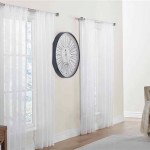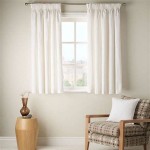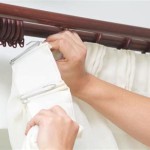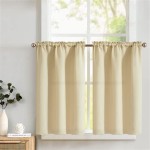How to Measure for Curtains with Grommets
Accurate measurement is critical for achieving a polished and functional window treatment, especially when selecting curtains with grommets. Grommets, also known as eyelets, are metal or plastic rings inserted into the top of the curtain panel, through which the curtain rod is threaded. This construction style creates a clean, modern look with deep, even folds. However, the way grommet curtains hang requires a slightly different approach to measuring compared to other curtain styles. Incorrect measurements can result in curtains that are too short, too long, or lack the fullness necessary for an aesthetically pleasing appearance. This article provides a comprehensive guide to measuring for grommet curtains, ensuring a proper fit and achieving the desired look for any window.
Before beginning the measurement process, it is essential to gather the necessary tools. A metal measuring tape is preferred for accuracy, as cloth tapes can stretch and provide inconsistent readings. A pencil and paper are needed to record the measurements. A stepladder may be required to reach higher windows comfortably and safely. Finally, the curtain rod should already be installed, as the measurements will be based on its position.
Determining the Curtain Rod Position and Length
The first step in measuring for grommet curtains is determining the optimal position and length of the curtain rod. This decision will significantly impact the perceived height and width of the window and the overall aesthetic of the room. Consider the following factors:
Rod Height: To create the illusion of a taller window, mount the curtain rod higher above the window frame than strictly necessary. A general guideline is to position the rod 4-6 inches above the top of the window frame. For particularly low ceilings, the rod can be mounted even higher, potentially closer to the ceiling, to maximize the perceived height of the room. However, ensure that there is sufficient space above the window frame to securely mount the rod and its brackets.
Rod Width: The curtain rod should extend beyond the width of the window frame on either side. This allows the curtains to be fully drawn back, exposing the entire window and maximizing natural light. A common recommendation is to extend the rod 6-12 inches beyond the window frame on each side. The specific extension will depend on the size of the window and the desired fullness of the curtains. A wider extension will result in more gathered curtains when fully drawn, while a narrower extension will produce a more streamlined look. If the window is close to a corner, the rod may need to be shorter to avoid obstructing adjacent walls or furniture.
Once the ideal position of the curtain rod has been determined, install the rod and its brackets securely. Verify that the rod is level using a level tool. This ensures that the curtains will hang evenly and prevent any unsightly sagging or tilting.
Measuring the Curtain Length
Measuring the curtain length for grommet curtains requires understanding how the grommets affect the final drop. The measurement is taken from the top of the curtain rod to the desired bottom hem position. However, the visible length of the curtain will be slightly shorter than this measurement due to the fabric above the grommets, known as the "header."
Measuring from the Top of the Rod: Use the metal measuring tape to measure from the top of the curtain rod to the desired bottom hem position. This position is a matter of personal preference and depends on the desired aesthetic and functionality. Common options include:
Floor Length: Curtains that extend to the floor create a formal and elegant look. For a precise, tailored appearance, the bottom hem should just graze the floor, approximately ½ inch above the surface. To achieve a more relaxed and flowing look, the curtains can "puddle" on the floor, extending 1-3 inches beyond the floor. Keep in mind that puddling curtains can accumulate dust and may not be suitable for high-traffic areas.
Sill Length: Curtains that end at the windowsill are a practical choice for windows where furniture is placed underneath or for kitchens and bathrooms where longer curtains may be a nuisance. The bottom hem should either touch or slightly overlap the windowsill, typically by ½ to 1 inch.
Apron Length: Curtains that end slightly below the windowsill are a compromise between sill length and floor length. They offer a more finished look than sill length curtains while still avoiding the potential drawbacks of floor length curtains. The bottom hem should extend approximately 4-6 inches below the windowsill.
Accounting for the Header: The measurement taken from the top of the curtain rod represents the total fabric length needed. However, because a portion of the fabric will be above the grommets, the visible length of the curtain will be shorter. To determine the actual drop of the curtain below the grommets, you will need to account for the header height.
The header height is the distance from the top of the curtain to the top of the grommet. This measurement is typically provided by the curtain manufacturer. Alternatively, you can measure the distance from the top of a sample grommet curtain to the top edge of the grommet. Subtract the header height from the total fabric length measurement to determine the visible length of the curtain below the grommets.
For example, if the measurement from the top of the rod to the floor is 84 inches, and the header height is 2 inches, the visible length of the curtain will be 82 inches. This means that the curtains will hang 2 inches shorter than the measurement taken from the top of the rod. Adjust the initial measurement accordingly to achieve the desired bottom hem position.
Determining the Curtain Width
Accurately determining the curtain width is just as important as the length. The width affects the fullness and drape of the curtains. Sufficient width is necessary to create the desired folds and prevent the curtains from appearing flat and stretched when drawn.
Measuring the Window Width and Rod Extension: Begin by measuring the total width of the window frame. Then, measure the distance that the curtain rod extends beyond the window frame on each side. Add these three measurements together to obtain the total width that the curtains need to cover.
Calculating the Required Fabric Width: To achieve adequate fullness, the curtain fabric width should be at least two to two and a half times the total width calculated in the previous step. This multiplier allows for the formation of deep, even folds when the curtains are drawn. For example, if the total width is 60 inches, the curtain fabric width should be between 120 and 150 inches.
Considering Single or Multiple Panels: The required fabric width can be achieved using a single wide panel or multiple narrower panels. Using multiple panels is often more practical, especially for wider windows, as it makes the curtains easier to handle and install. If using multiple panels, divide the total required fabric width by the number of panels to determine the width of each panel.
For example, if the total required fabric width is 140 inches and you plan to use two panels, each panel should be 70 inches wide. Ensure that the width of each panel is sufficient to create the desired fullness when the curtains are drawn. It is generally advisable to slightly overestimate the width rather than underestimate, as excess fabric can always be gathered or pleated to create a more tailored look.
When purchasing curtains, pay attention to the stated panel widths. These widths typically refer to the flat, ungathered width of the fabric. Remember to account for the gathering ratio (2x to 2.5x) when determining the appropriate number of panels and their individual widths. If purchasing custom-made curtains, provide the total width measurement and the desired fullness ratio to the manufacturer.
By following these detailed instructions, one can accurately measure for grommet curtains, ensuring a proper fit and achieving the desired aesthetic and functionality for the windows. Remember to double-check all measurements before ordering or purchasing curtains, and consider consulting with a professional if any uncertainty exists.

How To Measure For Grommet Top Curtains Vermont Country

Measurement Guide For Custom Curtains

Grommet Measuring And Fabrication Youtube

Measuring Guide Kgorge

How To Measure Curtains Guide Twopages

Custom Drapery Panel Grommet Best Fabric

Veeyoo Bedroom Blackout Curtains 2 Panels Thermal Insulated Grommet Window Curtain With Tiebacks Thick Darkening Drapes For Living Room 52 X 63 Inches Cognac Measuring

Grommet Top Curtains Tutorial A Step By Free Guide

Tutorial Diy Grommet Curtains Deuce Cities Henhouse

Top Grommet Window Curtain Panels Set Of 2








